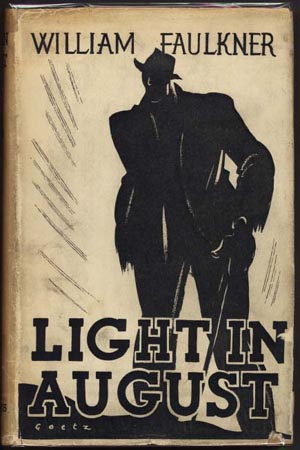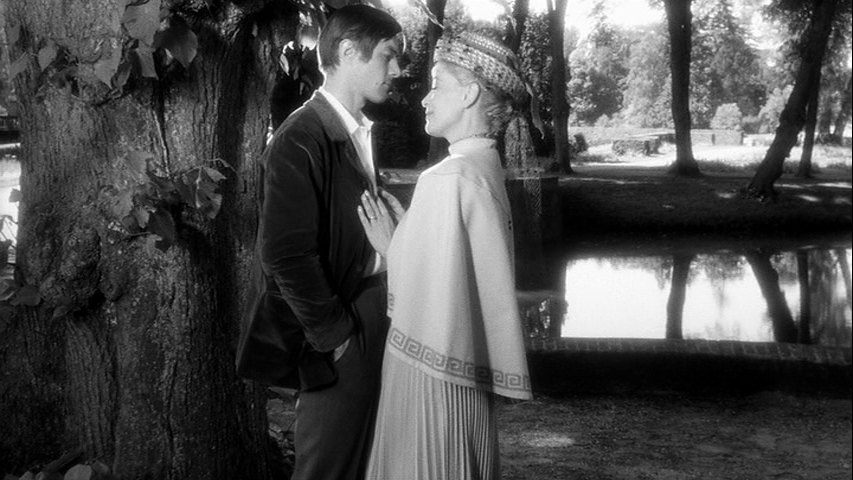Commissioned by Criterion’s The Current, and published there on October 26, 2010. — J.R.

For many decades now, William Faulkner’s Light in August (1932) and Carl Dreyer’s Gertrud (1964) have been major touchstones for me—not only separately but also in some mysterious relation to each other. I even managed to find a way of discussing these two works together over the first four paragraphs of my first book, Moving Places: A Life at the Movies (I also published a lengthy essay about Gertrud, in which I make glancing reference to the novel). The fact that Dreyer once expressed some interest in adapting Faulkner’s Light in August — an interest he shared with Luis Buñuel (and with actors Zachary Scott and Ruth Ford, a couple who once actually held the film rights) — was part of the inspiration and pretext for my musings about Dreyer and Faulkner, but for me the affinities run much deeper.
Both are works I take pleasure in revisiting every few years — they seem to grow in density each time — and I had occasion to revisit both of them this fall. I’m presently teaching film at Virginia Commonwealth University in Richmond, and last month, after starting a weekly cine-club there with a colleague, we hit upon the idea of showing Gertrud as our first film after another colleague, filmmaker Rob Tregenza, said he’d always wanted to see it. Having once viewed the film with the late novelist Iris Owens (author of the brilliant and about-to-be-reprinted After Claude), who disliked its slowness and its characters so intensely that she said that she’d rather leave the country than have to sit through it again, and recalling the reports of the film’s disastrous reception when it premiered in Venice and Paris, I was afraid that it would scare off some potential cine-club members. But in fact, they seemed to find it both fascinating and emotionally compelling, and the students who came all stuck around to discuss it afterward. So maybe we’re all finally starting to catch up with a forty-six-year-old film that was widely derided as out-of-date when it first appeared.
Light in August — still my favorite novel, discovered in my teens — was the focus of my master’s thesis. I analyzed its two major characters — Lena Grove (a pregnant young white woman on the road from Alabama, searching in Mississippi for the father of her child-to-be) and Joe Christmas (a doomed, bitter orphan of thirty-three with alleged biracial origins who can’t ever discover whether he’s white or black), who never meet—in terms of the respective styles of The Odyssey and the Old Testament, as described by Erich Auerbach in the brilliant first chapter of his Mimesis: seamless and untroubled in Homer, like figures on Keats’s Grecian urn, and turbulent and full of gaps, like expressionist bolts of lightning, in the story of Abraham. As Claire Denis recently suggested to me, it may be the best novel ever written about racism, and it’s also a profoundly troubled moral inquiry about the failure of southern Christianity to cope with racism. It boldly alternates pastoral comedy (Grove) with urban tragedy (Christmas), a cinematic form of stillness, presence, and persistence (Grove, who opens the novel in the present tense) with a very literary form of tortured narrative progression (Christmas).
It wasn’t until I read Maurice Drouzy’s still untranslated biography of Dreyer in the 1980s that I began to recognize Dreyer’s personal investment in the material of Light in August, especially in its two leading characters. Born illegitimate, he grew up idealizing his Swedish mother — who died when he was still an infant from her attempt to abort a second child—and hating his Danish foster parents. Two years after he left home as a teenager in 1906 (the same year that most of Gertrud’s action unfolds), he left Denmark for the first time to discover whatever he could about his mother in rural Sweden. Over half a century later, he was inspired to adapt Hjalmar Soderberg’s play Gertrud by adding an epilogue when he discovered that the real-life Swedish woman the title heroine was based on spent her final years only a few miles from where he’d been conceived. (Dreyer’s original plan, which he was unable to realize, was to shoot this epilogue on location in the woman’s home.)
For all its radical differences in period (1906), milieu (Copenhagen), and class (upper) from Light in August, Gertrud is no less preoccupied with questions about existential identity—for the implacable title heroine (who, like Lena Grove, lives in a continuous present and never changes) and for the various men who pursue or abandon her (preoccupied with the past and their own careers). There isn’t much room for comedy here (as we get in the final chapter of Light in August), certainly not in the tragic failure of the men to live up to Gertrud’s ideal of total love and commitment, or in Gertrud’s own tragic inability or refusal to compromise her ideals. But the tension between narrative and nonnarrative forms of presence, between stillness and instability, is remarkably similar in the two. And the piercing, exquisitely “overlit” flashbacks and epilogue of Gertrud evoke some of the charged luminosity of Faulkner’s world.



